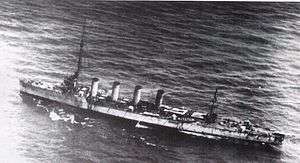Novara-class cruiser
 Novara, after the Battle of the Otranto Straits | |
| Class overview | |
|---|---|
| Name: | Novara class |
| Builders: | |
| Operators: | |
| Preceded by: | Admiral Spaun |
| Built: | 3 |
| In service: | 1914-1929 |
| Completed: | 3 |
| Retired: | 3 |
| General characteristics [1] | |
| Type: | Light cruiser |
| Displacement: |
|
| Length: | 130.6 m (428 ft 6 in) o/a |
| Beam: | 12.77 m (41 ft 11 in) |
| Draught: | 4.95–5.3 m (16.2–17.4 ft) |
| Propulsion: |
|
| Speed: | 27 knots (50 km/h; 31 mph) |
| Range: | 1,600 nautical miles (3,000 km; 1,800 mi) at 24 kn (44 km/h; 28 mph) |
| Complement: | 340 |
| Armament: |
|
| Armour: |
|
The Novara class, known as Rapidkreuzer or Helgoland-Klasse (in English literally rapid cruiser ) was a class of light scouting cruisers of the Austro-Hungarian Navy active during World War I. The ships were an improved design of the earlier SMS Admiral Spaun[lower-alpha 1] , which had been laid down in 1908.
Design
Main armament for the ships were nine 10 cm (3.9 in) guns and six torpedo tubes, an improvement over Admiral Spaun by two 10 cm guns. The lightly armored ships had a top speed of 27 knots (50 km/h; 31 mph). The weak point of the Novara class was its relatively light armament. Guns of 12 or 15 cm (5 or 6 in) were considered but not added due to the war situation.
Another three ships with 12 cm guns and maximum speed of 30 kn (56 km/h; 35 mph), projected as a replacement of Zenta-class, never got over planning phase.
Ships in class
Three ships were built and commissioned:
| Ship | Builder | Launched | Completed |
|---|---|---|---|
| SMS Saida | CNT, Trieste | 26 October 1912 | 1 August 1914 |
| SMS Helgoland | Danubius, Fiume | 23 November 1912 | 29 August 1914 |
| SMS Novara | Danubius, Fiume | 15 February 1913 | 10 January 1915 |
Service history
Together with the Tátra-class destroyers they were ideally suited to the naval warfare of the Adriatic Sea. Numerous fast raids on Italian ports were undertaken, the most spectacular action was the successful attack of Novara, Helgoland, and Saida on the Otranto Barrage on 15 May 1917; the three cruisers, along with two destroyers and three German U-boats sank 14 trawlers.
After the war the ships were given to the victorious Entente powers: France incorporated Novara under the name Thionville into its fleet (scrapped in 1942). Italy took over Helgoland and Saida as Brindisi and Venezia (both scrapped in 1937).
Notes
- ↑ "SMS" stands for "Seiner Majestät Schiff ", or "His Majesty's Ship" in German.
Citations
- ↑ Sifferlinger 2008, p. 8.
Bibliography
- Greger, René (1976). Austro-Hungarian Warships of World War I. London: Ian Allan. ISBN 0-7110-0623-7.
- Paul Schmalenbach: "Kurze Geschichte der k. u. k. Marine", Herford 1970 (ISBN 3-7822-0047-0)
- Erwin Sieche: "Kreuzer und Kreuzerprojekte der k.u.k. Kriegsmarine 1889-1918", Hamburg 2002 (ISBN 3-8132-0766-8 and ISBN 3-7083-0012-2)
- Sifferlinger, Nikolaus (2008). Rapidkreuzer Helgoland. Im Einsatz für Österreich-Ungarn und Italien [Scouting Cruiser Helgoland. In Service for Austria-Hungary and Italy] (in German). Wien, Graz: NW Neuer Wissenschaftlicher Verlag. ISBN 9783708301334.
External links
- Details and photos of Admiral Spaun (text in German)
- Details and photos of Saida, Helgoland and Novara (text in German)
- Post war distribution of Austro-Hungarian warships
